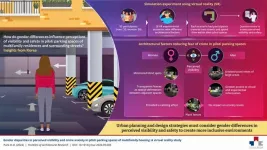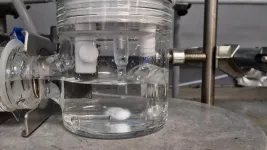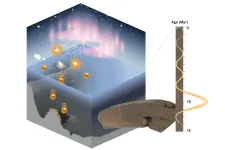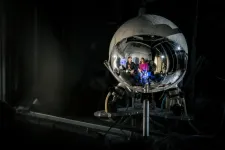(Press-News.org) Multifamily residential buildings with multiple floors are common in South Korea. These buildings usually have pilotis—support structures like pillars that elevate the building, creating an open ground floor generally used for parking vehicles. These piloti parking spaces are often risky to navigate for pedestrians and residents due to limited visibility, unclear boundaries between adjacent areas, and poor management. For instance, these spaces have blind spots that criminals could exploit, which induces fear among people.
Though evidence-based architectural design strategies can improve urban safety, few studies have examined the relationship between the architectural designs of piloti parking spaces, perceived visibility, and crime anxiety. With the rise in gender-based crimes, it is also crucial to understand how gender influences these dynamics.
In this vein, a research team including Assistant Professor So Yeon Park from the School of Architecture at Seoul National University of Science and Technology, South Korea, Professor Gisung Han from the Korea Advanced Institute of Science and Technology, Assistant Professor Jee Heon Rhee, Gachon University, and Professor. Kyung Hong Lee from the Korea University investigated how different architectural configurations of piloti parking spaces and surrounding streets impacted visibility and fear of crime among men and women. Dr. Park highlights, “We also propose design strategies for improving the environment of piloti parking areas and reducing users' fear of crime.” The study was made available online on November 15, 2024, in the journal Frontiers of Architectural Research.
Researchers used virtual reality (VR) to conduct simulation experiments with 85 participants. They created 28 scenarios with varying entrance, boundary, structure, and lighting configurations. Each participant navigated four scenarios and completed questionnaires integrated into the virtual environment to assess perceived visibility and safety.
“Consistent with previous studies, perceived visibility significantly reduced fear of crime for both genders. However, men and women prioritized different aspects of visibility,” says Dr. Park.
For men, any obstruction in their view of the surroundings negatively impacted their visibility. For women, architectural features like walls and side entrances, which create blind spots, negatively impacted their visibility. This is because women were more concerned with unexpected threats within their immediate vicinity than having a clear view of their surroundings.
Unlike men, women prioritized architectural features that offered both visibility and safety. They perceived transparent fences not as visual barriers but as spatial boundaries between nearby spaces and physical barriers that offered protection while allowing women to monitor their surroundings. Similarly, plant fences had a calming effect that reduced crime anxiety among women.
Personal histories also shaped the fear of crime. While men’s experiences of living in multifamily housing reduced their crime anxiety, women’s experiences of victimization increased their crime anxiety.
Thus, architects and urban planners must ensure gender-sensitive design to create safer, inclusive urban environments. Dr. Park emphasizes, “Design strategies like having unobstructed visibility can reduce crime anxiety among men, while having transparent or low-height tree fences and minimizing blind spots can mitigate women’s fear and increase surveillance.”
Hopefully, these insights will direct global efforts toward incorporating innovative approaches like VR in urban planning and creating safer cities for all genders.
***
Reference
DOI: 10.1016/j.foar.2024.09.005
About the institute Seoul National University of Science and Technology (SEOULTECH)
Seoul National University of Science and Technology, commonly known as 'SEOULTECH,' is a national university located in Nowon-gu, Seoul, South Korea. Founded in April 1910, around the time of the establishment of the Republic of Korea, SEOULTECH has grown into a large and comprehensive university with a campus size of 504,922 m2.
It comprises 10 undergraduate schools, 35 departments, 6 graduate schools, and has an enrollment of approximately 14,595 students.
Website: https://en.seoultech.ac.kr/
About Assistant Professor So Yeon Park
Dr. So Yeon Park is an Assistant Professor at the School of Architecture, Seoul National University of Science and Technology, South Korea. She earned her PhD in Architecture from Korea University and worked as a postdoctoral researcher at the Delft University of Technology. Her expertise lies in analyzing human behavior in built environments using various methods, including VR experiments, surveys, interviews, systematic observations, and simulations. Her research provides evidence-based design strategies to enhance individuals' physical, emotional, and psychological well-being.
END
Researchers have developed a sustainable catalyst that increases its activity during use while converting carbon dioxide (CO2) into valuable products. This discovery offers a blueprint for designing next-generation electrocatalysts.
A collaborative team from the University of Nottingham's School of Chemistry and the University of Birmingham have developed a catalyst made of tin microparticles supported by a nanotextured carbon structure. The interactions between the tin particles and graphitised ...
Years before tau tangles show up in brain scans of patients with Alzheimer's disease, a biomarker test developed at the University of Pittsburgh School of Medicine can detect small amounts of the clumping-prone tau protein and its misfolded pathological forms that litter the brain, cerebrospinal fluid and potentially blood, new research published today in Nature Medicine suggests.
The cerebrospinal fluid biomarker test correlates with the severity of cognitive decline, independent of other factors, including brain amyloid deposition, thereby opening doors for early-stage disease diagnosis ...
Beryllium-10, a rare radioactive isotope produced by cosmic rays in the atmosphere, provides valuable insights into the Earth's geological history. A research team from the Helmholtz-Zentrum Dresden-Rossendorf (HZDR), in collaboration with the TUD Dresden University of Technology and the Australian National University (ANU), has discovered an unexpected accumulation of this isotope in samples taken from the Pacific seabed. Such an anomaly may be attributed to shifts in ocean currents or astrophysical events that occurred approximately 10 million years ago. The findings hold the potential to serve as a global time marker, representing a promising ...
A new mathematical model sheds light on how the brain processes different cues, such as sights and sounds, during decision making. The findings from Princeton neuroscientists may one day improve how brain circuits go awry in neurological disorders, such as Alzheimer’s, and could help artificial brains, like Alexa or self-driving car technology, more helpful.
The findings were published February 10 in the journal Nature Neuroscience.
Walking to work, commuters encounter many sensory signals along their route, such as the glow of a crosswalk signal that indicates whether it’s safe to cross or beware of oncoming traffic. ...
Financial markets are reacting not just to Donald Trump's return to the White House but also to the unpredictability of this victory, according to a new study from the University of Surrey. Investors must diversify their portfolios to mitigate risks associated with political volatility and to remain vigilant about the potential for abrupt market corrections.
A new study, published in Economics Letters, indicates that while there was an immediate surge in stock prices following Trump's election, this was quickly tempered by investor concerns over potential trade wars and international instability.
A group of ...
Why do our mental images stay sharp even when we are moving fast? A team of neuroscientists led by Professor Maximilian Jösch at the Institute of Science and Technology Austria (ISTA) has identified a mechanism that corrects visual distortions caused by movement in animals. The study, conducted in mice, identifies a core function that can be generalized across the vertebrate visual system, including primates such as humans. The findings are published in Nature Neuroscience.
Despite its rapid development in recent decades, the video camera industry is still catching up with the capabilities of the human eye. In particular, action cams are designed ...
Euclid blasted off on its six-year mission to explore the dark Universe on 1 July 2023. Before the spacecraft could begin its survey, the team of scientists and engineers on Earth had to make sure everything was working properly. During this early testing phase, in September 2023, Euclid sent some images back to Earth. They were deliberately out of focus, but in one fuzzy image Euclid Archive Scientist Bruno Altieri saw a hint of a very special phenomenon and decided to take a closer look.
“I look at the data from Euclid as it comes in,” explains Bruno. “Even from that first observation, I could see it, but after Euclid made more observations of the area, ...
The report “Assessing Deep-Tech Innovation Hubs in Germany: The Case of Biotechnology” evaluates Germany’s performance in deep-tech innovation within biotech using a comprehensive index and examines five key hubs: Berlin, Heidelberg, Munich, Nuremberg-Erlangen, and Stuttgart. These hubs were analyzed in terms of fundamental research, research and development in biotech, startup activity, public infrastructure, and business environment.
Berlin, Munich, and Heidelberg are the leading biotech hubs
Berlin leads the index due to its strong public infrastructure ...
Experiencing pain may increase the odds that cancer survivors will use cigarettes and cannabis, according to a recent study published by Wiley online in CANCER, a peer-reviewed journal of the American Cancer Society. The study also found that cigarette smoking and pain are linked to more treatment-related side effects and worse health among cancer survivors.
Pain and use of cigarettes, e-cigarettes, alcohol, and cannabis commonly occur together in the general population. To characterize pain in relation to such non-opioid substance ...
Scientists have found that taking a playful approach to life doesn’t mean you don’t take your situation seriously, but it can mean you cope with it better. By surveying people about their experiences during a Covid-19 lockdown, they learned that more playful people were more positive about the future and coped more actively and creatively. Life gave them lemons, and they made lemonade.
“Our study revealed that playfulness and resilience are intimately connected through what we call ‘lemonading’ — the ability to imagine ...





